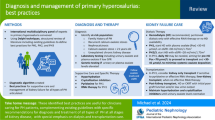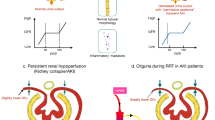Abstract
Background
Chronic kidney-related sequelae after STEC-HUS occur in 20–40% of patients. Hyperuricemia (HU) may cause acute and chronic toxicity involving the kidneys. We retrospectively assessed if there was an association between the presence of HU during the acute illness and that of kidney-related sequelae in children with STEC-HUS.
Methods
Children with STEC-HUS who had clinical and laboratory data at 2 years of follow-up were included in this case–control study. Univariate and multivariate analyses were performed between patients with (cases) or without (controls) kidney-related sequelae to identify factors associated with outcomes, including different measures of serum uric acid (sUA) (baseline level, peak, and duration of HU). HU was defined as sUA > 8 mg/dL.
Results
Of 86 patients included, 77.9% had HU. Patients with sequelae (n = 41) had a higher prevalence of HU (41/41 vs. 26/45, p < 0.01), higher baseline leukocyte count, serum creatinine (sCr), and sUA levels as well as lower sodium than controls. During hospitalization, cases also had higher sCr peak, sUA peak and duration of HU, requirement and duration of dialysis, extrarenal complications, and hypertension. By multivariate analysis, after adjusting for length of dialysis, only duration of HU (p = 0.0005; OR 1.7, 95% CI 1.27–2.36) remained as an independent predictor of sequelae, with a best cutoff of 5.5 days (AUC 0.95, specificity 80%, sensitivity 100%).
Conclusions
The presence of HU is a common finding in children with STEC-HUS and its duration during the acute stage was associated with kidney-related sequelae, regardless of the duration of dialysis.
Graphical abstract

A higher resolution version of the Graphical abstract is available as Supplementary Information





Similar content being viewed by others
References
Grisaru S (2014) Management of hemolytic-uremic syndrome in children. Int J Nephrol Renovasc Dis 7:231–239. https://doi.org/10.2147/IJNRD.S41837
Alconcher LF, Coccia PA, Suarez ADC, Monteverde ML, Perez Y Gutiérrez MG, Carlopio PM, Missoni ML, Balestracci A, Principi I, Ramírez FB, Estrella P, Micelli S, Leroy DC, Quijada NE, Seminara C, Giordano MI, Hidalgo Solís SB, Saurit M, Caminitti A, Arias A, Rivas M, Risso P, Liern M (2018) Hyponatremia: a new predictor of mortality in patients with Shiga toxin-producing Escherichia coli hemolytic uremic syndrome. Pediatr Nephrol 33:1791–1798. https://doi.org/10.1007/s00467-018-3991-6
Spinale JM, Ruebner RL, Copelovitch L, Kaplan BS (2013) Long-term outcomes of Shiga toxin hemolytic uremic syndrome. Pediatr Nephrol 28:2097–2105. https://doi.org/10.1007/s00467-012-2383-6
Cobeñas CJ, Alconcher LF, Spizzirri AP, Rahman RC (2007) Long-term follow-up of Argentinean patients with hemolytic uremic syndrome who had not undergone dialysis. Pediatr Nephrol 22:1343–1347. https://doi.org/10.1007/s00467-007-0522-2
Ejaz AA, Johnson RJ, Shimada M, Mohandas R, Alquadan KF, Beaver TM, Lapsia V, Dass B (2019) The role of uric acid in acute kidney injury. Nephron 142:275–283. https://doi.org/10.1159/000499939
Kim IY, Lee DW, Lee SB, Kwak IS (2014) The role of uric acid in kidney fibrosis: experimental evidences for the causal relationship. Biomed Res Int 2014:638732. https://doi.org/10.1155/2014/638732
Vaziri ND, Freel RW, Hatch M (1995) Effect of chronic experimental renal insufficiency on urate metabolism. J Am Soc Nephrol 6:1313–1317. https://doi.org/10.1681/ASN.V641313
Hogg R (2020) “Disproportionate” hyperuricemia in children with hemolytic uremic syndrome (HUS): should we regard this as a “medical emergency”? Pediatr Nephrol 35:2205–2210. https://doi.org/10.1007/s00467-020-04713-1
Balestracci A, Meni Battaglia L, Toledo I, Martin SM, Puyol I, Beaudoin L, Robledo NL (2021) Diagnostic sensitivity of extended renal and hematologic criteria to define hemolytic uremic syndrome. Arch Argent Pediatr 119:238–244. https://doi.org/10.5546/aap.2021.eng.238
Rivas M, Miliwebsky E, Chinen I, Deza N, Leotta GA (2006) The epidemiology of hemolytic uremic syndrome in Argentina. Diagnosis of the etiologic agent, reservoirs and routes of transmission. Medicina (B Aires) 66(Suppl 3):27–32
Davis TK, McKee R, Schnadower D, Tarr PI (2013) Treatment of Shiga toxin-producing Escherichia coli infections. Infect Dis Clin North Am 27:577–597. https://doi.org/10.1016/j.idc.2013.05.010
Goldman SC, Holcenberg JS, Finklestein JZ, Hutchinson R, Kreissman S, Johnson FL, Tou C, Harvey E, Morris E, Cairo MS (2001) A randomized comparison between rasburicase and allopurinol in children with lymphoma or leukemia at high risk for tumor lysis. Blood 97:2998–3003. https://doi.org/10.1182/blood.v97.10.2998
Weaver DJ Jr (2019) Uric acid and progression of chronic kidney disease. Pediatr Nephrol 34:801–809. https://doi.org/10.1007/s00467-018-3979-2
Ninchoji T, Nozu K, Nakanishi K, Horinouchi T, Fujimura J, Yamamura T, Minamikawa S, Ishimori S, Nakanishi K, Yoshikawa N, Morioka I, Kaito H, Iijima K (2017) Clinical characteristics and long-term outcome of diarrhea-associated hemolytic uremic syndrome: a single center experience. Clin Exp Nephrol 21:889–894. https://doi.org/10.1007/s10157-016-1376-3
Balestracci A, Martin SM, Toledo I, Alvarado C, Wainsztein RE (2014) Laboratory predictors of acute dialysis in hemolytic uremic syndrome. Pediatr Int 56:234–239. https://doi.org/10.1111/ped.12245
Ardissino G, Daccò V, Testa S, Civitillo CF, Tel F, Possenti I, Belingheri M, Castorina P, Bolsa-Ghiringhelli N, Tedeschi S, Paglialonga F, Salardi S, Consonni D, Zoia E, Salice P, Chidini G (2015) Hemoconcentration: a major risk factor for neurological involvement in hemolytic uremic syndrome. Pediatr Nephrol 30:345–352. https://doi.org/10.1007/s00467-014-2918-0
Vaterodt L, Holle J, Hüseman D, Müller D, Thumfart J (2018) Short- and long-term renal outcome of hemolytic-uremic syndrome in childhood. Front Pediatr 6:220. https://doi.org/10.3389/fped.2018.00220
Rahman RC, Cobeñas CJ, Drut R, Amoreo OR, Ruscasso JD, Spizzirri AP, Suarez Adel C, Zalba JH, Ferrari C, Gatti MC (2012) Hemorrhagic colitis in postdiarrheal hemolytic uremic syndrome: retrospective analysis of 54 children. Pediatr Nephrol 27:229–233. https://doi.org/10.1007/s00467-011-1973-z
Nathanson S, Kwon T, Elmaleh M, Charbit M, Launay EA, Harambat J, Brun M, Ranchin B, Bandin F, Cloarec S, Bourdat-Michel G, Piètrement C, Champion G, Ulinski T, Deschênes G (2010) Acute neurological involvement in diarrhea-associated hemolytic uremic syndrome. Clin J Am Soc Nephrol 5:1218–1228. https://doi.org/10.2215/CJN.08921209
Goldstein B, Giroir B, Randolph A, International Consensus Conference on Pediatric Sepsis (2005) International pediatric sepsis consensus conference definitions for sepsis and organ dysfunction in pediatrics. Pediatr Crit Care Med 6:2–8. https://doi.org/10.1097/01.PCC.0000149131.72248.E6
Srinath AI, Lowe ME (2013) Pediatric pancreatitis. Pediatr Rev 34:79–90. https://doi.org/10.1542/pir.34-2-79
Suri RS, Clark WF, Barrowman N, Mahon JL, Thiessen-Philbrook HR, Rosas-Arellano MP, Zarnke K, Garland JS, Garg AX (2005) Diabetes during diarrhea-associated hemolytic uremic syndrome: a systematic review and meta-analysis. Diabetes Care 28:2556–2562. https://doi.org/10.2337/diacare
KDIGO CKD Work Group (2013) KDIGO 2012 clinical practice guideline for the evaluation and management of chronic kidney disease. Kidney Int Suppl 3:1–150. https://www.kisupplements.org/article/S2157-1716(16)30005-3/fulltext
Caletti MG, Balestracci A, Missoni M, Vezzani C (2013) Additive antiproteinuric effect of enalapril and losartan in children with hemolytic uremic syndrome. Pediatr Nephrol 28:745–750. https://doi.org/10.1007/s00467-012-2374-7
Schwartz GJ, Haycock GB, Edelmann CM Jr, Spitzer A (1976) A simple estimate of glomerular filtration rate in children derived from body length and plasma creatinine. Pediatrics 58:259–263
Hogg RJ, Furth S, Lemley KV, Portman R, Schwartz GJ, Coresh J, Balk E, Lau J, Levin A, Kausz AT, Eknoyan G, Levey AS, National Kidney Foundation's Kidney Disease Outcomes Quality Initiative (2003) National Kidney Foundation’s Kidney Disease Outcomes Quality Initiative clinical practice guidelines for chronic kidney disease in children and adolescents: evaluation, classification, and stratification. Pediatrics 111:1416–1421. https://doi.org/10.1542/peds.111.6.1416
Cubillos CMP, Del Salas P, Zambrano PO (2015) Microalbuminuria in pediatric patients diagnosed with hemolytic uremic syndrome. Rev Chil Pediatr 86:92–96. https://doi.org/10.1016/j.rchipe.2015.04.019
Flynn JT, Kaelber DC, Baker-Smith CM, Subcommittee on screening and management of high blood pressure in children et al (2017) Clinical practice guideline for screening and management of high blood pressure in children and adolescents. Pediatrics 140:e20171904. https://doi.org/10.1542/peds.2017-3035
Mickey RM, Greenland S (1989) The impact of confounder selection criteria on effect estimation. Am J Epidemiol 129:125–137. https://doi.org/10.1093/oxfordjournals.aje.a115101
Sun GW, Shook TL, Kay GL (1996) Inappropriate use of bivariable analysis to screen risk factors for use in multivariable analysis. J Clin Epidemiol 49:907–916. https://doi.org/10.1016/0895-4356(96)00025-x
Gianantonio C, Vitacco M, Mendilaharzu F, Rutty A, Mendilaharzu J (1964) The hemolytic uremic syndrome. J Pediatr 64:478–491. https://doi.org/10.1016/s0022-3476(64)80337-1
Spizzirri FD, Rahman RC, Bibiloni N, Ruscasso JD, Amoreo OR (1997) Childhood hemolytic uremic syndrome in Argentina: long-term follow-up and prognostic features. Pediatr Nephrol 11:156–160. https://doi.org/10.1007/s004670050248
Kubota M (2019) Hyperuricemia in children and adolescents: present knowledge and future directions. J Nutr Metab 2019:3480718. https://doi.org/10.1155/2019/3480718
Gruskin AB, Naiman JL, Polinsky MS, Baluarte HJ, Kaiser BA, Perlnan SA, Morgenstern BZ (1984) Dev Nephrol. In: Strauss J (ed) . Springer, Boston, pp 33–42
Koratala A, Singhania G, Alquadan KF, Shimada M, Johnson RJ, Ejaz AA (2016) Serum uric acid exhibits inverse relationship with estimated glomerular filtration rate. Nephron 134:231–237. https://doi.org/10.1159/000448629
Kuge R, Morikawa Y, Hasegawa Y (2017) Uric acid and dehydration in children with gastroenteritis. Pediatr Int 59:1151–1156. https://doi.org/10.1111/ped.13366
Balestracci A, Martin SM, Toledo I, Alvarado C, Wainsztein RE (2012) Dehydration at admission increased the need for dialysis in hemolytic uremic syndrome children. Pediatr Nephrol 27:1407–1410. https://doi.org/10.1007/s00467-012-2158-0
Ardissino G, Tel F, Possenti I, Testa S, Consonni D, Paglialonga F, Salardi S, Borsa-Ghiringhelli N, Salice P, Tedeschi S, Castorina P, Colombo RM, Arghittu M, Daprai L, Monzani A, Tozzoli R, Brigotti M, Torresani E (2016) Early volume expansion and outcomes of hemolytic uremic syndrome. Pediatrics 137(1). https://doi.org/10.1542/peds.2015-2153
Fahlen MT, Batuman V (2019) Uric acid nephropathy. https://emedicine.medscape.com/article/244255-overview. Accessed 28 July 2022
Johnson RJ, Nakagawa T, Jalal D, Sánchez-Lozada LG, Kang DH, Ritz E (2013) Uric acid and chronic kidney disease: which is chasing which? Nephrol Dial Transplant 28:2221–2228. https://doi.org/10.1093/ndt/gft029
Hogg R (2022) An evaluation of the roles of hematuria and uric acid in defining the prognosis of patients with IgA nephropathy. Pediatr Nephrol 37:947–958. https://doi.org/10.1007/s00467-021-05092-x
Obermayr RP, Temml C, Gutjahr G, Knechtelsdorfer M, Oberbauer R, Klauser-Braun R (2008) Elevated uric acid increases the risk for kidney disease. J Am Soc Nephrol 19:2407–2413. https://doi.org/10.1681/ASN.2008010080
Kang DH, Nakagawa T, Feng L, Watanabe S, Han L, Mazzali M, Truong L, Harris R, Johnson RJ (2002) A role for uric acid in the progression of renal disease. J Am Soc Nephrol 13:2888–2897. https://doi.org/10.1097/01.asn.0000034910.58454.fd
Ohno I, Hosoya T, Gomi H, Ichida K, Okabe H, Hikita M (2001) Serum uric acid and renal prognosis in patients with IgA nephropathy. Nephron 87:333–339. https://doi.org/10.1159/000045939
Ficociello LH, Rosolowsky ET, Niewczas MA, Maselli NJ, Weinberg JM, Aschengrau A, Eckfeldt JH, Stanton RC, Galecki AT, Doria A, Warram JH, Krolewski AS (2010) High-normal serum uric acid increases risk of early progressive renal function loss in type 1 diabetes: results of a 6-year follow-up. Diabetes Care 33:1337–1343. https://doi.org/10.2337/dc10-0227
Rodenbach KE, Schneider MF, Furth SL, Moxey-Mims MM, Mitsnefes MM, Weaver DJ, Warady BA, Schwartz GJ (2015) Hyperuricemia and progression of CKD in children and adolescents: the chronic kidney disease in children (CKiD) cohort study. Am J Kidney Dis 66:984–992. https://doi.org/10.1053/j.ajkd.2015.06.015
O’Regan S, Rousseau E (1988) Hemolytic uremic syndrome: urate nephropathy superimposed on an acute glomerulopathy? An hypothesis. Clin Nephrol 30:207–210
Balestracci A, Martin SM, Toledo I (2012) Hyperuricemia in children with post-diarrheal hemolytic uremic syndrome. Pediatr Nephrol 27:1421–1422. https://doi.org/10.1007/s00467-012-2181-1
Acosta AA, Hogg RJ (2012) Rasburicase for hyperuricemia in hemolytic uremic syndrome. Pediatr Nephrol 27:325–329. https://doi.org/10.1007/s00467-011-2047-y
Balestracci A, Meni Battaglia L, Martin SM, Toledo I (2020) Rasburicase in hemolytic uremic syndrome related to Shiga toxin-producing Escherichia coli: a report of nine cases. Pediatr Nephrol 35:1133–1137. https://doi.org/10.1007/s00467-020-04528-0
Cho MH, Ahn YH, Lim SH, Kim JH, Ha IS, Cheong HI, Kang HG (2020) Rasburicase improves the outcome of acute kidney injury from typical hemolytic uremic syndrome. Pediatr Nephrol 35:2183–2189. https://doi.org/10.1007/s00467-020-04644-x
Monet-Didailler C, Godron-Dubrasquet A, Madden I, Delmas Y, Llanas B, Harambat J (2019) Long-term outcome of diarrhea-associated hemolytic uremic syndrome is poorly related to markers of kidney injury at 1-year follow-up in a population-based cohort. Pediatr Nephrol 34:657–662. https://doi.org/10.1007/s00467-018-4131-z
Author information
Authors and Affiliations
Corresponding author
Ethics declarations
Ethics approval
The study was performed in accordance with the ethical standards of the institutional research and ethics committee.
Conflict of interest
The authors declare no competing interests.
Additional information
Publisher's note
Springer Nature remains neutral with regard to jurisdictional claims in published maps and institutional affiliations.
Supplementary Information
Below is the link to the electronic supplementary material.
Rights and permissions
Springer Nature or its licensor holds exclusive rights to this article under a publishing agreement with the author(s) or other rightsholder(s); author self-archiving of the accepted manuscript version of this article is solely governed by the terms of such publishing agreement and applicable law.
About this article
Cite this article
Balestracci, A., Meni Battaglia, L., Toledo, I. et al. Hyperuricemia: an unrecognized risk factor for kidney-related sequelae in children with hemolytic uremic syndrome. Pediatr Nephrol 38, 1547–1557 (2023). https://doi.org/10.1007/s00467-022-05753-5
Received:
Revised:
Accepted:
Published:
Issue Date:
DOI: https://doi.org/10.1007/s00467-022-05753-5




